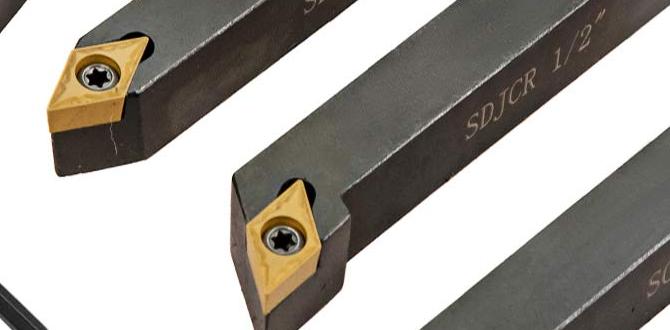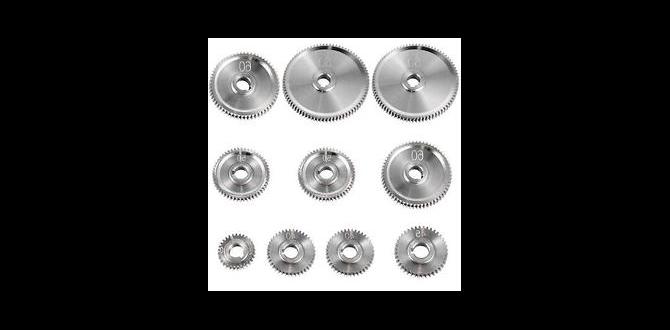The Tialn Ball Nose End Mill is a game-changer for effortlessly machining small pockets in mild steel, offering smooth finishes and extended tool life thanks to its advanced coating.
Ah, the dreaded small pocket in mild steel. If you’ve ever tried to create one with a standard end mill, you know the struggle: chattering, rough surfaces, and a tool that seems to dull before your eyes. It can be frustrating, especially when you’re just starting out with your milling machine. Well, I’ve got some good news! There’s a special kind of tool that makes this job surprisingly easy and incredibly effective. We’re talking about a specific type of ball nose end mill, coated with TiAlN, that’s like a secret weapon for mild steel. Stick around, and I’ll walk you through exactly why it’s so brilliant and how you can use it to achieve fantastic results in your workshop.
Why Your Standard End Mill Struggles with Small Pockets in Mild Steel
Let’s face it, mild steel is a popular material for hobbyists and DIYers. It’s affordable, easy to work with (usually!), and great for all sorts of projects. But when you need to mill out a small, intricate pocket, a regular end mill can start to feel like wrestling a greased pig.
Heat Buildup: Milling generates heat. In small pockets, chips don’t have much room to escape, causing them to recut and friction to skyrocket. This heat is the enemy of cutting tools, leading to faster wear and poor surface finish.
Chatter and Vibration: When an end mill enters and exits the material, especially in tight spaces, it can cause vibrations. This “chatter” leaves a rough, wavy surface that’s difficult to clean up. It also puts a lot of stress on your tool and machine.
Chip Evacuation Issues: Imagine tiny metal shavings getting trapped in a small cut. They can weld themselves to the cutting edge, making it effectively duller and causing more friction and heat. It’s a vicious cycle!
Edge Rounding: Standard end mills are designed for general-purpose cutting. They don’t have the specialized geometry or coatings to handle the demands of high-speed, small-pocket milling in tougher materials without quickly losing their sharp edges.
This is where our hero of the day comes in: the TiAlN ball nose end mill.
Meet the TiAlN Ball Nose End Mill: Your New Best Friend for Mild Steel
So, what exactly makes a TiAlN ball nose end mill so special? It’s a combination of its shape and its coating.
The Ball Nose Advantage
A ball nose end mill has a rounded tip, like the end of a ball. This means it cuts with a radius rather than a sharp corner.
Smooth Contours: For curved surfaces or internal fillets, the ball nose is designed to create a seamless, flowing shape.
Reduced Stress Concentration: Unlike square-shouldered end mills, the rounded tip distributes cutting forces more evenly, reducing stress at the cutting edge. This is particularly helpful in smaller features where a sharp corner could easily chip.
Ideal for Pockets: Even if your pocket isn’t strictly curved, the ball nose shape allows for smoother entry and exit into the material, reducing the tendency for chatter. It can also create a radiused bottom in the pocket, which is often desirable.
The TiAlN Coating: A Shield Against Heat and Wear
Now for the magic ingredient: the TiAlN coating. TiAlN stands for Titanium Aluminum Nitride. This isn’t just a thin layer of paint; it’s a super-hard, ceramic-like material applied to the end mill flutes.
Extreme Hardness: TiAlN is incredibly hard, significantly harder than the steel it’s cutting. This hardness allows it to maintain its sharp cutting edge for much longer, even at high temperatures.
Heat Resistance: This is where TiAlN truly shines for mild steel. It can withstand much higher cutting temperatures than uncoated or even TiN-coated tools. When cutting steel, high temperatures are unavoidable. TiAlN forms a protective oxide layer at high heat, further increasing its resistance to wear and preventing material from welding to the cutting edge.
Reduced Friction: The smooth, ceramic-like surface of the coating reduces friction between the tool and the workpiece. Less friction means less heat generation and a cleaner cut.
Extended Tool Life: Because it resists wear and heat so well, a TiAlN coated end mill will last significantly longer when cutting mild steel compared to its uncoated counterparts. This is a huge cost-saver for any workshop.
Better Surface Finish: With less friction and heat, and a sharper edge maintained longer, the TiAlN coating helps produce a smoother, cleaner surface finish on your workpiece.
The “35 Degree” Nuance
You might see “35-degree” mentioned with TiAlN ball nose end mills, especially for mild steel. This often refers to the helix angle or the relief angle behind the cutting edge. A 35-degree helix angle is a good general-purpose angle for milling steel. It provides a good balance between chip evacuation and rigidity. For small pockets, this balance is crucial.
For a beginner working with mild steel, a TiAlN coated ball nose end mill, perhaps with a 35-degree helix angle, is an excellent choice for tackling those tricky small pockets.
When to Choose a TiAlN Ball Nose End Mill for Mild Steel
This specialized tool isn’t for every milling task, but for certain jobs, it’s simply the best option.
Creating Rounded Internal Corners: If your design calls for a smooth fillet or radius in the bottom of a pocket or slot, a ball nose is the only tool that can do it directly.
Machining Small, Intricate Pockets: This is its specialty. When the depth and width of your pocket are fairly small, and you need a clean finish without chatter, this is your guy.
Reducing Tool Chatter: The rounded profile and hard coating help to dampen vibrations, leading to smoother cutting.
Improving Tool Life in Steel: If you’re doing a lot of steel milling, especially in less-than-ideal conditions (like deep small pockets), the TiAlN coating will significantly extend the lifespan of your end mill.
Achieving a High-Quality Surface Finish: For parts where appearance matters, the TiAlN ball nose will deliver a superior finish.
Roughing and Semi-Finishing: While often thought of for finishing, the TiAlN ball nose can also be used for roughing passes in small pockets, especially if you’re using a trochoidal milling strategy (more on that later).
Essential Considerations Before You Start Milling
Before you plunge that shiny new TiAlN ball nose end mill into your workpiece, let’s cover a few vital points to ensure success and safety.
1. Choosing the Right Size
For “small pockets,” common sizes might range from 1mm to 10mm in diameter.
Diameter vs. Pocket Size: Ensure your end mill diameter is smaller than the width of the pocket you intend to mill. For precision, you typically want the end mill diameter to be about 50-75% of the pocket width, depending on the milling strategy. For instance, if your pocket is 10mm wide, a 6mm or 8mm ball nose end mill is a good starting point.
Depth of Cut: The tool’s length and reach are also important. Ensure the end mill can reach the required depth without excessive deflection.
2. Understanding Your Machine’s Capabilities
Not all milling machines are created equal.
Spindle Speed (RPM): Your machine needs to be capable of the appropriate spindle speeds required for your end mill size and material. Higher speeds are often needed for smaller diameter tools.
Rigidity: A more rigid machine will minimize chatter, especially when using smaller tools in small pockets.
Coolant/Lubrication: While TiAlN helps immensely with heat, using a cutting fluid or mist coolant can further improve performance, extend tool life, and help evacuate chips.
3. Setting Up Your Workpiece Securely
This cannot be stressed enough: safety first!
Clamping: Your workpiece must be clamped down firmly using a vise, clamps, or fixtures. A workpiece that moves during machining is incredibly dangerous.
Workholding Rigidity: Ensure your vise or clamps are also securely fastened to the machine table.
4. Knowing Your Material Properties (Mild Steel)
While we’re focusing on mild steel, remember that “mild steel” can vary in its exact composition and hardness. A quick check of the material specification sheet, if available, is always a good idea. Generally, mild steel is forgiving, but understanding its approximate hardness helps in selecting feed and speed parameters. You can find general cutting data for mild steel on resources like MachineryShop.co.uk’s cutting data information.
Step-by-Step: Milling Small Pockets with Your TiAlN Ball Nose End Mill
Let’s get down to the practical steps of using your new favorite tool!
Step 1: Secure Your Workpiece and Tool
Mount the End Mill: Insert your TiAlN ball nose end mill into your collet or tool holder and tighten it securely in the machine spindle.
Clamp the Workpiece: Ensure your mild steel workpiece is firmly clamped in your milling vise or on the machine table. Double-check that it won’t move during the operation.
Step 2: Set Up Your Machining Parameters (Speeds & Feeds)
This is crucial for a good cut and tool longevity. Finding the exact perfect settings often comes with experience and testing, but here’s a good starting point:
1. Surface Speed (SFM or Vc): This is the speed at which the cutting edge moves through the material. For mild steel with a TiAlN coated carbide end mill, a good starting range is 300-600 SFM (Surface Feet per Minute). For example, if your steel is around 400 SFM and you have a 6mm (approx 0.25 inch) end mill:
RPM = (SFM 3.25) / Diameter (inches)
RPM = (400 3.25) / 0.25 = 5,200 RPM.
Always start conservatively and adjust.
2. Chip Load (IPT or Fz): This is the thickness of the chip that each cutting edge removes. For TiAlN coated carbide end mills in mild steel, a chip load of 0.001 to 0.003 inches per tooth (ipt) is a common starting point. For a 2-flute end mill, this means a feed rate per minute (FMM) of:
FMM = RPM Number of Flutes Chip Load (inches)
FMM = 5200 2 0.002 = 20.8 inches per minute (ipm).
Again, start conservatively.
3. Depth of Cut (ap): This is how deep the tool cuts into the material in a single pass. For small pockets, you might need to take multiple shallow passes. A good rule of thumb is to keep the axial depth of cut (how deep the tool goes down) to no more than 50% of the tool diameter. For radial depth of cut (how wide a step it takes sideways), this can be much shallower, around 10-20% of the tool diameter for full slotting, or even less if “pocketing”.
Table 1: Suggested Starting Parameters for TiAlN Ball Nose End Mill in Mild Steel (6mm Diameter)
| Parameter | Value (Imperial) | Value (Metric approx.) | Notes |
| :——————– | :——————— | :——————— | :—————————————————————– |
| Material | Mild Steel | Mild Steel | General purpose mild steel |
| End Mill Type | TiAlN Coated Ball Nose | TiAlN Coated Ball Nose | Carbide recommended |
| End Mill Diameter | 0.25 inch | 6 mm | |
| Flutes | 2 | 2 | 2 or 4 flute common. 2 flute often better for steel. |
| Surface Speed (Vc) | 300 – 600 SFM | 90 – 180 m/min | Start in the middle or lower end. Listen to the cut. |
| Chip Load per Tooth | 0.001 – 0.003 ipt | 0.025 – 0.075 mm/t | Very important for tool life and finish. Start small. |
| Axial Depth of Cut (ap)| 0.05 – 0.125 inch | 1.25 – 3 mm | Typically up to 50% of tool diameter. Take shallower if needed. |
| Radial Depth of Cut | 0.02 – 0.05 inch | 0.5 – 1.25 mm | For pocketing, it’s often a small stepover (10-20% of diameter). |
| Spindle Speed (RPM) | ~ 3800 – 7600 RPM | ~ 3800 – 7600 RPM | Calculated: RPM = (SFM 3.25) / Diameter(in) |
| Feed Rate (FMM) | ~ 15 – 45 ipm | ~ 380 – 1140 mm/min | Calculated: FMM = RPM Flutes Chip Load (in) |
| Coolant | Flood or Mist | Flood or Mist | Recommended for best results, especially in small pockets. |
Important Note on Speeds and Feeds: These are starting points. Always prioritize listening to your machine and looking at the chips.
Too loud/chattery: Reduce feed rate or depth of cut.
Ribbons of stringy chips: Likely too hot, reduce speed or increase coolant.
Powdery chips: Possibly too slow or too much coolant washing away heat.
Step 3: Program Your Toolpath
This is where your CAM software (if you’re using one) or manual programming comes in. For small pockets, you’ll typically use:
Pocketing Strategy: This strategy involves the tool moving across the pocket area, usually in a back-and-forth or spiral pattern, removing material.
Trochoidal Milling (High-Speed Machining – HSM): This advanced technique uses a small radial stepover and a high feed rate to maintain a consistent chip load. It can be very effective for slotting and pocketing, as it keeps the cutter engaged in a more controlled way, reducing heat and shock. The ball nose geometry is excellent for this. For beginners, a simpler pocketing strategy is often easier to implement.
Ensure your program defines:
The correct tool diameter.
The correct tool length offset.
The Z-depth for the bottom of the pocket.
The XY coordinates defining the pocket’s perimeter.
Appropriate entry and exit moves.
Step 4: The First Pass (The “Air Cut” and Gentle Entry)
Dry Run (Optional but Recommended): If you’re nervous, program your toolpath to cut in the air a few inches above the workpiece. Watch the machine execute the moves to ensure your program looks correct.
Set Z-Zero: Accurately set your Z-axis zero point on the top surface of your workpiece.
Controlled Entry: Program a gentle lead-in move for your tool. Avoid plunging straight down into the material unless absolutely necessary and the tool is designed for it (e.g., a specific form mill). A ramping or helical entry is much kinder to the tool.
Step 5: Perform the Machining Operation
Engage Coolant: If using, turn on your coolant system.
Start the Spindle: Bring your spindle up to the programmed RPM.
Initiate Feed: Start the cutting feed.
Monitor Closely: Watch and listen to the entire operation.
Are the chips forming correctly (small, manageable, clearing the pocket)?
Is the sound of the cut consistent, or is it chattering?
Is there excessive smoke or signs of overheating?
Make Adjustments: If you notice issues like chatter, reduce the feed rate slightly. If the cut seems too light, you might cautiously increase the feed rate or depth of cut on subsequent passes once you’re comfortable.
Step 6: Finishing and Inspection
Cool Down: Allow the tool and workpiece to cool before touching them, especially after a long cut.
Clean the Pocket: Use compressed air or a brush to clear away any remaining chips.
Measure: Use calipers, a depth micrometer, or gage pins to verify that the pocket dimensions are within your required tolerances.
Inspect the Finish:** Look at the surface finish. It should be relatively smooth, without deep gouges or obvious chatter marks.
Advanced Milling Techniques for Small Pockets
While the basic pocketing strategy is effective, for more demanding applications or when pushing the limits of your machine, you might explore these.
Trochoidal Milling (Adaptive Clearing)
This is a highly efficient method, especially for steel. Instead of taking a large stepover and a shallower depth, trochoidal milling uses a very small radial stepover (often 10-20% of the tool diameter) combined with a much larger axial depth of cut that the tool can handle. The tool moves in a series of overlapping arcs, maintaining a consistent engagement angle and







